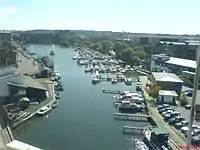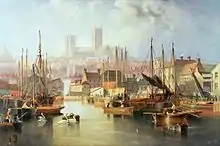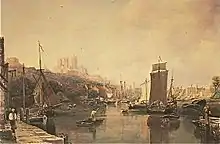Brayford Pool
The Brayford Pool is a natural lake formed from a widening of the River Witham in the centre of the city of Lincoln in England. It was used as a port by the Romans - who connected it to the River Trent by constructing the Foss Dyke - and has a long industrial heritage.[1]

Today, the waterfront surrounding the pool is home to a range of hotels, restaurants, bars, entertainment venues and a modern University (University of Lincoln).[2] There is also a year-long programme of events on the waterfront including vehicle displays, music evenings and carnival parades.[3]
History


The Pool has been the focus of Lincoln's urban regeneration since the early 1990s. It is now overlooked by bars, restaurants, a cinema and, most significantly, the University of Lincoln. The only reminder of the past is the Royal William public house, a traditional pub housed inside a listed building. The Pool is used as a marina by houseboats and pleasure craft, as well as by anglers and kayakers.[4]
The Brayford Pool is known for its large population of mute swans (Cygnus olor).[4] The swans made the news in 2004, over concerns about the animals' diet and overall health, as well as the appearance on the Pool of a number of Australian black swans (Cygnus atratus).[5][6]
Also located on the Brayford Pool is the Lincoln Unit of the Sea Cadet Corps - T.S. Wrangler.
Brayford Island is in the Pool.
References
- "How the Brayford Pool played a major part in Lincoln's economy". Lincolnshire Echo. 13 January 2013. Archived from the original on 21 January 2013. Retrieved 31 July 2013.
- Brayford Waterfront (Visit Lincoln)
- Brayford events (Visit Lincoln)
- "Explore the Brayford". Visit Lincoln. Retrieved 31 July 2013.
- ""Chips and bread" killing swans". BBC News Online. 10 December 2004.
- Britten, Nick (9 September 2004). "Swans fight it out in cathedral test". Daily Telegraph. Retrieved 31 July 2013.
External links
| Wikimedia Commons has media related to Brayford Pool. |
